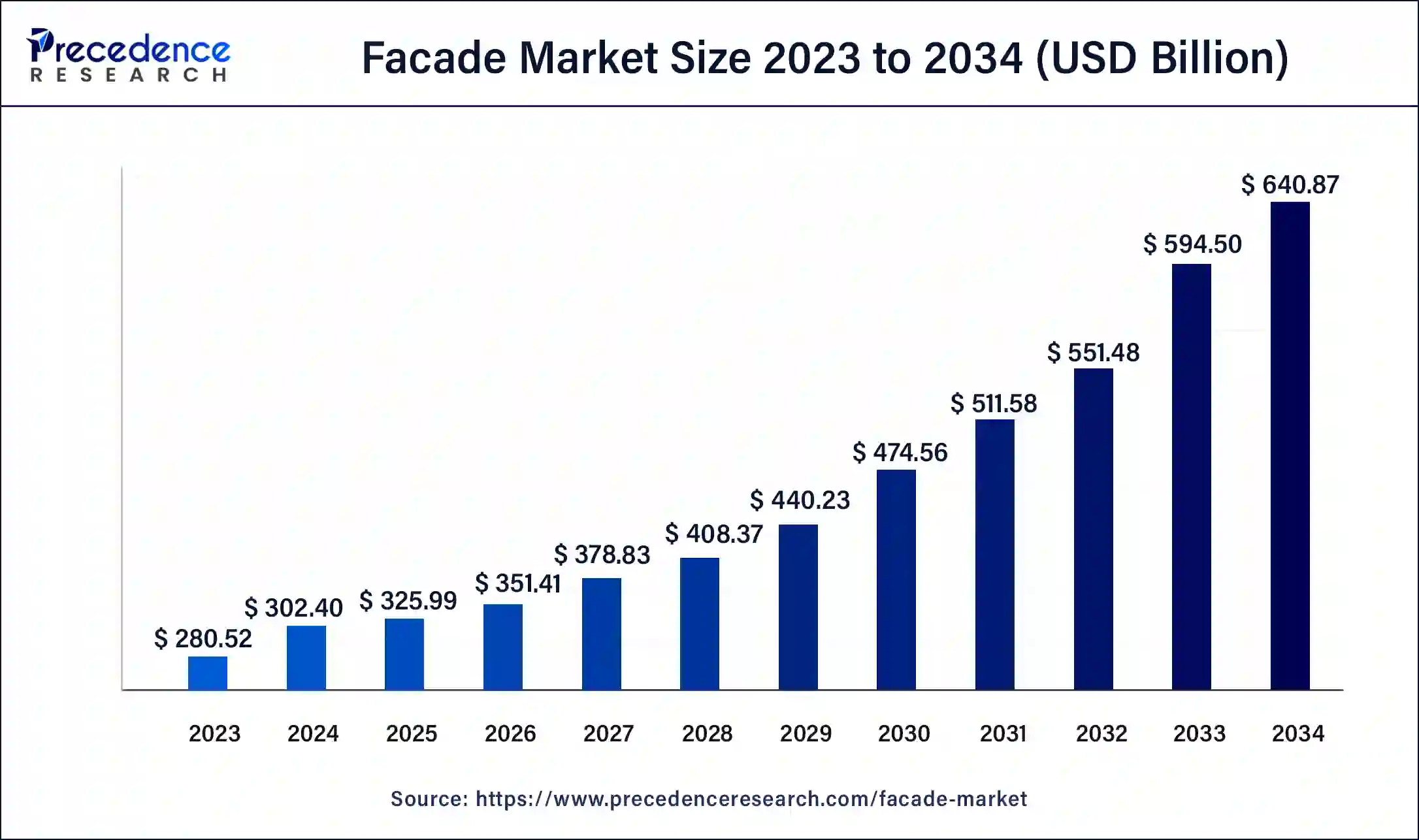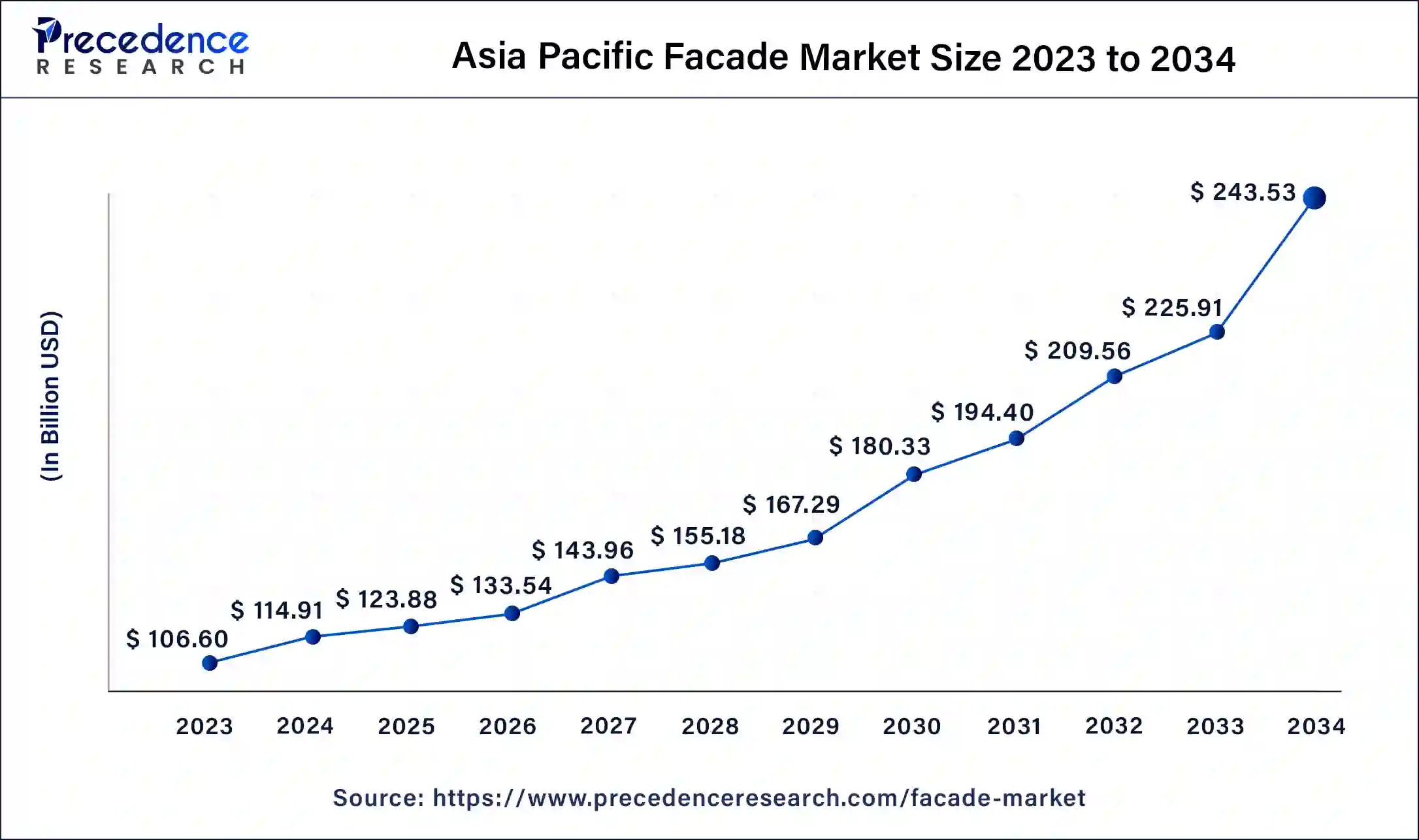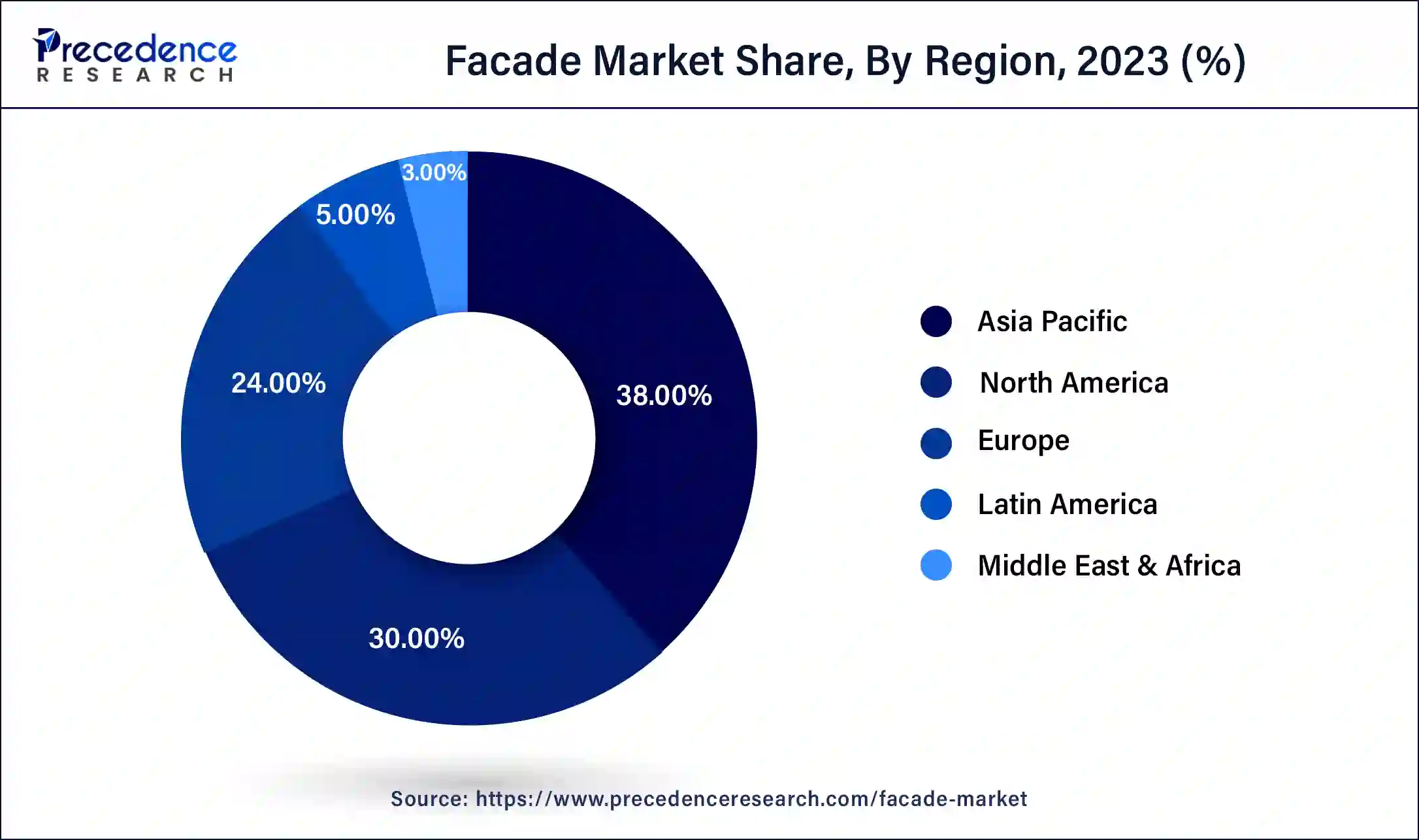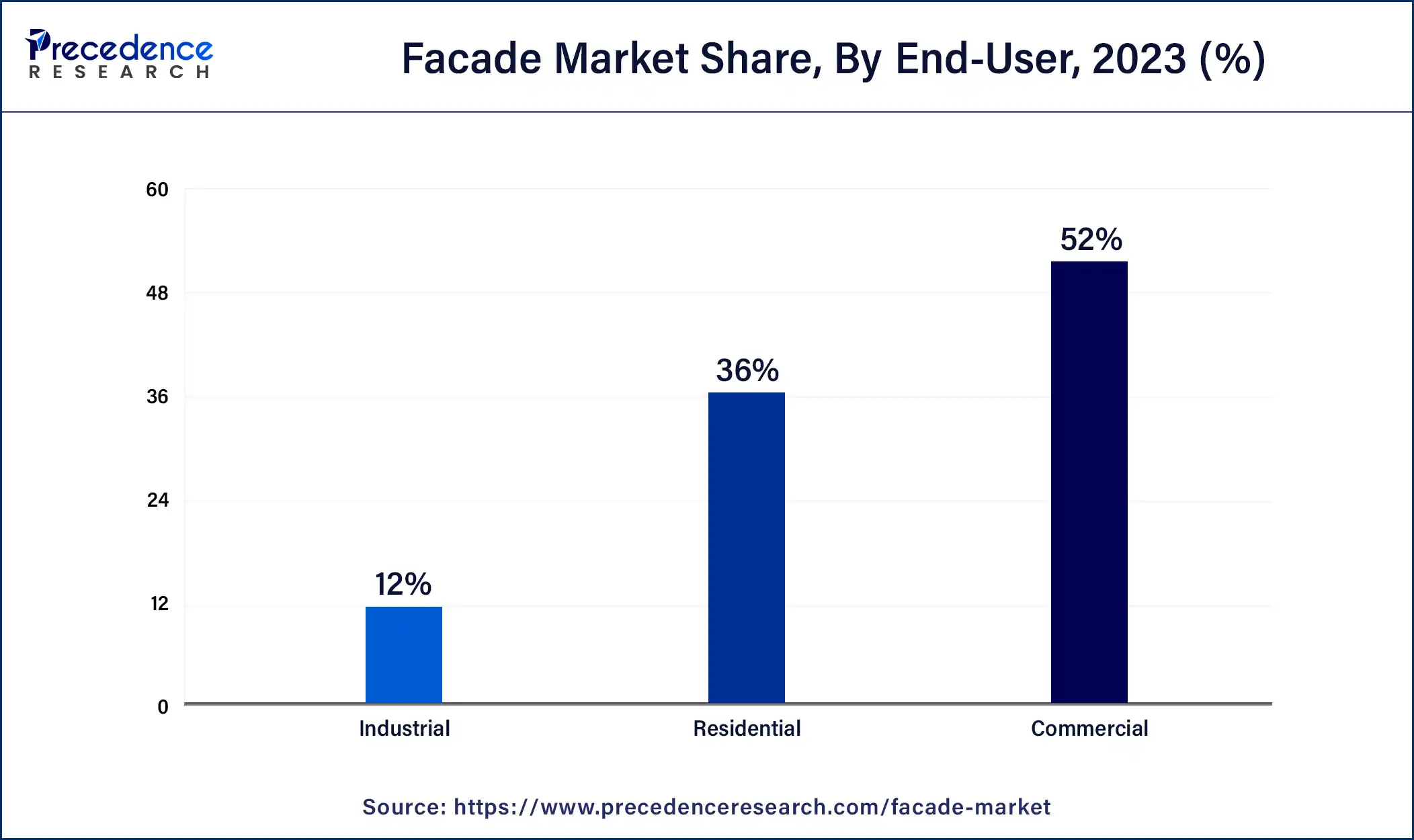List of Contents
Facade MarketSize and Growth 2025 to 2034
The global facade market size accounted for USD 302.40 billion in 2024, and is anticipated to hit around USD 325.99 billion by 2025, and is expected to reach around USD 640.87 billion by 2034, expanding at a CAGR of 7.8% from 2025 to 2034.

Facade Market Key Takeaways
- In terms of revenue, the market is valued at $325.99 billion in 2025.
- It is projected to reach $640.87 billion by 2034.
- The market is expected to grow at a CAGR of 7.80% from 2025 to 2034.
- By region, Asia Pacific dominated the market with the maximum market share of 38% in 2024, the region is expected to maintain its position during the forecast period.
- By product, the ventilated facades segment dominated the market in 2023, the segment is expected to grow at a significant share during the forecast period.
- By end-user, the commercial segment dominated the market with the largest market share of 52% in 2024. Additionally, the residential segment is expected to grow significantly during the forecast period.
Asia Pacific Facade Market Size and Growth 2025 to 2034
The Asia Pacific facade market size is estimated at USD 123.88 billion in 2025 and is predicted to be worth around USD 243.53 billion by 2034, at a CAGR of 6.7% from 2025 to 2034.

Asia Pacific is expected to sustain its position in the market during the forecast period. The growth of the region is attributed to the rising industrial, commercial and residential construction activities in the region. The rising population is one of the major factors for the developing commercial and residential sectors. Facades are sustainable, innovative designs in the facades, and safety is the major concern that is responsible for the growth of the facades market across the region.
Asia Pacific is dominating the façade market. The growth in infrastructure, construction activities, and a large number of urbanizations contribute half of the proportion to façade industries. Another factor influencing the growth of this region is the industrial sector. The increased foreign investment in industries boosts the demand for this market.
China is observed to be the largest contributor for the market's growth for the upcoming period. The advancements in façade installation techniques, availability of labors, cost-effective material and rising investments in the construction industry are a few factors to fuel the country's growth.
North America is expected to account for a notable share of the market during the forecast period. The growth of the market in the region is expected to be boosted due to the rising construction industry across the region. Increasing demand for solar facades from the countries like the United States and Canada will contribute to the growth of the market during the forecast period. Rising government initiatives for the development of the construction sector is expected to propel the growth of the façade market in North America.
The Middle East is expected to grow at a considerable pace during the anticipated period. Rising government support for the development of real-estate industry and developing economies in the region is fueling the growth of the market across the region. The gulf countries, such as Dubai, Qatar, Kuwait showing and tremendous growth in the real-estate industry and in the fancy world class buildings, these would result in the higher demand for the façades. These factors will contribute to the growth of the market in the Middle East.

Market Overview
The facade market usually deals with building facades while it covers the development and distribution of materials, designs and technologies associated with building facades. The façade market revolves around multiple elements including metal, glass, cladding systems and insulation. Facades are generally referred to as one part of the building, mostly the front side of the building's architecture.
In recent times it has become one of the most important parts of the building which offers an aesthetic look and unique character to the building construction. Facades can be installed in the new building or in the building which is under the renovation process. Rising construction activities across the globe are likely to contribute to the growth of the facades market. The increase in the market is attributed to the rising demand from the commercial and industrial sectors.
Technological Advancement
Technological advancements in the façade market feature smart façades, an automated shading system, dynamic glazing, digital technologies, glass processing, integrated solar panels, and modular facades. The dynamic glazing uses technologies such as electrochromic glass, also known as smart glass adjust the volume of shading. The smart facades use microprocessors, sensors, and actuators, which help with real-time control of the climate factors like humidity, light, and temperature. The modular facades are a prefabricated modular system that helps in reducing waste. The advancement in materials includes lightweight composite materials, which provide customization of designs.
The digital technologies consist of computer numerical control (CNC) machines and 3D printing. It helps in panel production and customization. Glass processing advancement gives access to the use of complex shapes and extra-large glass panes. Façade in solar panels is the integration of photovoltaic cells, which supports renewable energy and enables sustainability in the façade market.
Facade Market Growth Factors
Multiple commercial buildings including offices and malls try to maintain the aesthetics of buildings, facade plays a big role in the outer structure of the building through their detrimental effects. Such rising demand will act as a growth factor for the market. Facades are also beneficial for energy efficiency, apart from the aesthetic functionality facades play an important role in the consumption of energy by reducing energy bills, facades minimize the absorption of heat hence it reduces the cooling loads of the buildings which results in lower energy bills. One of the major valuable characteristics of the facades is the resistance to temperature and humidity.
In addition, solar facades are considered one of the most emerging types of facades. These advanced types of solar facades absorb solar energy and are used in several residential and commercial buildings as a secondary source of energy. The rising demand from regions like Asia Pacific, North America, and the Middle East is enhancing the growth of the facades market.
Market Scope
| Report Coverage | Details |
| Market Size by 2034 | USD 640.87 Billion |
| Market Size in 2025 | USD 325.99 Billion |
| Market Size in 2024 | USD 302.40 Billion |
| Growth Rate from 2025 to 2034 | CAGR of 7.80% |
| Largest Market | Asia Pacific |
| Base Year | 2024 |
| Forecast Period | 2025 to 2034 |
| Segments Covered | Product, End-use, and Region |
| Regions Covered | North America, Europe, Asia-Pacific, Latin America, and Middle East & Africa |
Market Dynamics
Drivers
Higher energy performance
Energy efficiency is crucial when it comes to building construction, and environmental effect is a crucial aspect of any project. The best use of natural light and ventilation can be made possible by a well-structured facade. Glass facades allow for more natural light to enter buildings, reducing the need for artificial lighting. Such facades can now regulate and cool a building's interior thanks to new breakthroughs in glass materials. Overall, while offering high energy performances, the facades reduce the overall cost invested in cooling the infrastructure. Thus, the element is observed to fuel the market's growth.
Restraint
Lack of flexibility
The lack of flexibility in the facades market can restrain innovation and adaptability. It may lead to limited design options, making it harder to meet diverse aesthetic and functional requirements. Without flexibility, the industry might struggle to respond to changing environmental regulations and energy efficiency demands, hindering its overall growth and competitiveness of the market.
Opportunity
Development of kinetic facades
Kinetic facades are dynamic facades that change rather than static, as the name suggests. Its elements can be programmed to react to environmental elements, to increase energy efficiency, decrease solar heat, or for aesthetic purposes, such as an art piece. In addition to this, these kinetic facades offer some rain protection, they do not significantly improve thermal performance. By adjusting their position, kinetic facades can control the amount of natural light and heat entering the building, thus contributing to energy savings and reducing the need for artificial lighting and cooling. Thus, the rising requirement and development for kinetic facades present opportunities for the market to grow.
Product Insights
The ventilated facades dominated the market with the largest market share in 2024, the segment will continue to grow at a significant rate during the forecast period. The growth of the segment is attributed to higher adoption of ventilated facades by the cold regions across the world. Ventilated facades are dry-installed exterior surface for building. The main objective of the ventilated facades is to maintain the exchange of air, light, and heat that goes between the interior and exterior of the building. It can be installed in the new building infrastructure or the building which is under renovation process. The ventilated facades are mainly made up of glass material that can transfer heat to provide a low temperature. There is rising demand from cold-weathered countries like countries in the European region for ventilated facades. Therefore, the segment is projected to witness significant growth during the forecast period.
On the other hand, the non-ventilated facades segment is expected to grow steadily during the forecast period. Non-ventilation facades are constructed with no ventilation or air cavity. such facades are made of a single-layer, non-ventilated structure. This structure is mostly constructed on slopped roofs for residential purposes. They offer a slim design due to its no ventilation structure, the installations of non-ventilated facades also reduce the time of installation during the building construction.
End-User Insights
The commercial segment dominated the market with the largest market growth in 2024, the segment is expected to generate a considerable and significant revenue during the forecast period. The growth of the segment is attributed to the rising use of facades for the protection of the interior and for giving a visually appealing look to the outer surface. The rising commercial and industrial construction across the world, especially in the developing countries, significantly promotes the segment's growth. Facades for commercial sector often have demand from retail shops, hotels, warehouses, malls and office buildings, to maintain the outer appearance of the building.

The residential segment is expected to witness a significant shift in its market share during the predicted time period. Facades installed for houses generally require low maintenance. The demand for facades from residential sector is observed to grow with the rising retrofitting activities for homes and residential buildings.
Facade Market Companies
- Fundermax
- Gartner (Permasteelisa Group)
- HansenGroup
- Hochtief
- National Enclosure Company, LLC.
- Schuco International (OTTO FUCHS KG)
- Skanska
- Trimo d.o.o.
- Norsk Hydro ASA
- YKK AP Inc.
- Rockpanel Group (ROCKWOOL B.V.)
- Aluplex
- Bouygues
- Enclos
- EOS Framing Limited
- Saint-Gobain Group
- AFS International B.V.
- Kingspan Group
- Lindner Group
Recent Developments
- In June 2024, Royal Jaarbeurs announced a new biennial trade event in spring 2025 for the European Façade Industry. The launch of this new event is to strengthen the partnership with the European Façade Network (EFN), TU Darmstadt, and TU Delft.
- In May 2024, Dow announced a capacity extension in SAS Chemicals for the high-performance façade industry. Dow initiated the effort through the minority equity investment.
- In September 2024, Pura Facades launched an initiative to improve cladding knowledge. The half-day courses will be provided in person. The initiative is developed with the help of designers and architects for a better understanding.
- In Nov 2022, Saint Globen extended its partnership with the PV manufacturer Megasol for increasing its range of facades portfolio. The agreement reveals that the company Saint Globen occupies the minority stake in Megasol's unit which manufactures and develop BIPV solution in their Deitingen site in Switzerland.
- In April 2023, Solar Energy Systems ISE and the Fraunhofer Institute get a partnership with the industry partners for its TABSOLAR III research project for the development of new solar thermal facade panel as a part of it.
- In March 2023, “Vitro X™ Innovation Partnerships” the launch is proudly announced by the Vitro Architectural Glass, a new partnership program launch is announced for developing and identifying an innovator solution for the future challenges of the glass industry.
Segments Covered in the Report
By Product
- Ventilated Facades
- Non-ventilated Facades
By End-use
- Commercial
- Residential
- Industrial
By Region
- North America
- Europe
- Asia-Pacific
- Latin America
- Middle East and Africa
For inquiries regarding discounts, bulk purchases, or customization requests, please contact us at sales@precedenceresearch.com
Frequently Asked Questions
Ask For Sample
No cookie-cutter, only authentic analysis – take the 1st step to become a Precedence Research client